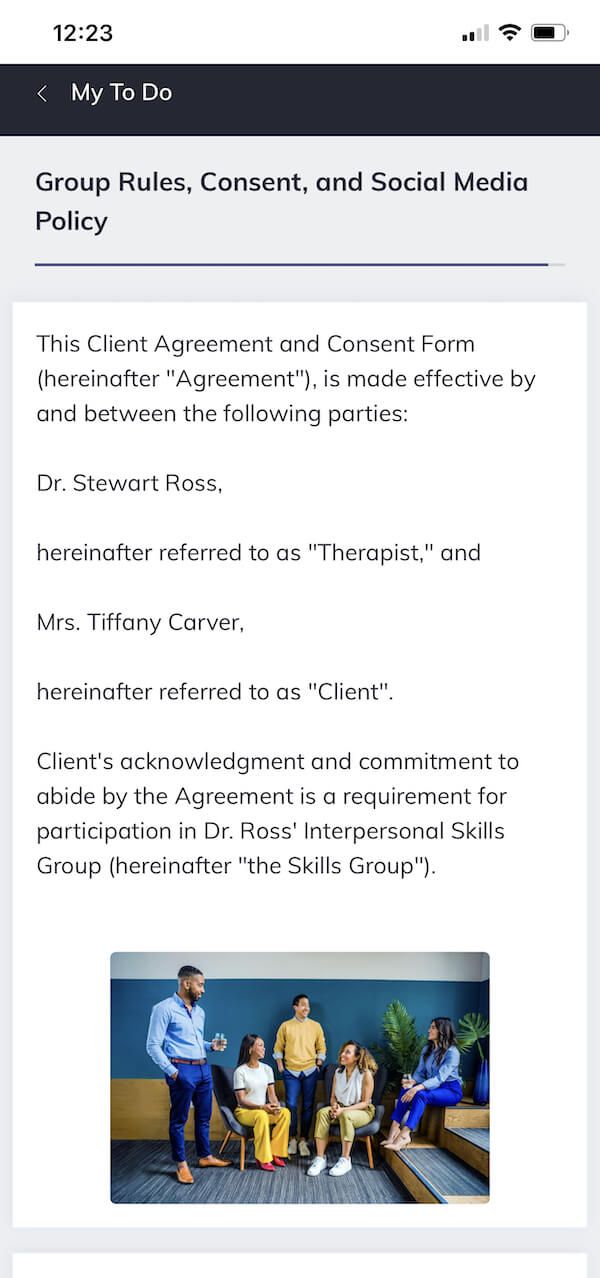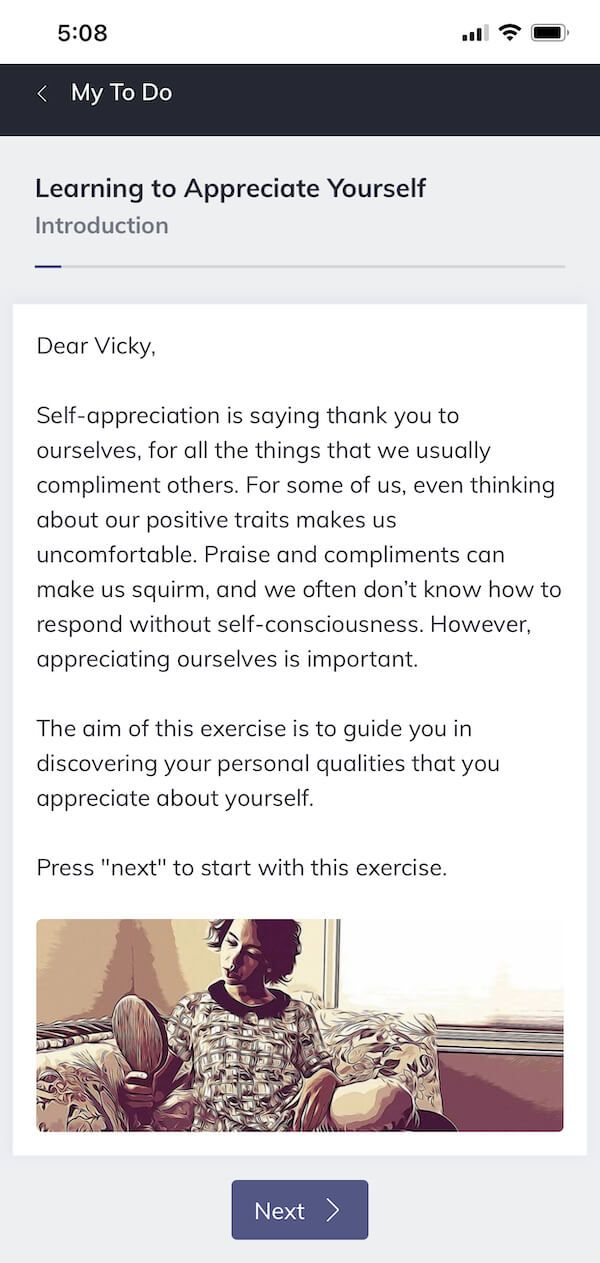Providing Psychoeducation in Groups: 5 Examples & Ideas
 Psychoeducational groups provide opportunities for their members to learn about a range of psychological phenomena.
Psychoeducational groups provide opportunities for their members to learn about a range of psychological phenomena.
For instance, they can facilitate greater self-insight and interpersonal functioning. They might also help their members gain skills to understand and solve problems that affect their functioning in daily life (Brown, 2018b).
Importantly, group psychoeducation can be applied in the context of many conditions and disorders, including phobias, mood disorders, and substance abuse.
In this article, we’ll walk you through some best-practice tips for providing psychoeducation in groups. We’ll also provide you with 10 useful templates and ideas to help you design sessions that use modern digital psychotherapy tools.
Before you continue, we thought you might like to download our three Positive Psychology Exercises for free. These science-based exercises will explore fundamental aspects of positive psychology including strengths, values, and self-compassion, and will give you the tools to enhance the wellbeing of your clients, students, or employees.
This Article Contains:
How to Provide Psychoeducation in Group Therapy
If you’re considering offering group psychoeducation, there are several important decisions to make and initial steps to take before diving into your first session.
In general, these initial steps occur in three phases (Brown, 2018b):
- Planning
Information gathering surrounding the target audience of the group and their needs, presenting challenges, and demographics. - Structural decisions
Selection of members, whether the group will be open or closed, environmental factors, and a framework for the sessions. - The specifics
Deciding on the group’s purpose, rules, informed consent policies, social media policies, session plans, and evaluation plans.
This article will focus predominantly on the specifics, focusing on intake forms, policy documents, and ideas for particular group activities that meet a range of different psychoeducational goals.
For a comprehensive guide to designing a psychoeducational group from the ground up, be sure to check out professor Nina Brown’s (2018a) book, Conducting Effective and Productive Psychoeducational and Therapy Groups.
Determining a Group’s Purpose, Goals, and Objectives

The nature of a group’s sessions will differ depending on this chosen aim.
For instance, imagine a group of 10 young adults who struggle to form relationships because of social anxiety and weak interpersonal skills. An educational group might work to teach these young adults about different theories of relationships and frameworks surrounding effective communication.
In contrast, a training group might involve role-play and hands-on practice in communication, while a support group might provide opportunities for participants to empathize with one another and receive encouragement.
There can often be overlap between a group’s purposes, but it is important that facilitators are clear about a group’s primary purpose from the outset to minimize tangents and the risk of losing focus.
Flowing from this exploration of a group’s purpose should be a consideration of its goals. For instance, a group that aims to provide social skills training might work toward the goal of increasing participants’ self-reported confidence in social situations (Brown, 2018b).
Likewise, a group should have clear behavioral objectives. The therapist must ask themselves what their participants should be able to do (or do differently) following group sessions. An example might be that upon the conclusion of a particular group session, participants become able to confidently introduce themselves and their occupation to someone they have just met.
Psychoeducation in Groups: 3 Examples
Now that we’ve considered the steps involved in determining your group’s purpose, let’s look at three examples of how to design group sessions that meet these aims.
In several of the examples that follow, we’ll draw on a range of pre-made tools and psychoeducational activities from the comprehensive psychotherapy platform Quenza.
Quenza is an easy-to-use online tool designed to connect therapists with science-backed psychoeducational content in a range of audio and visual formats.
The platform also enables clients to engage with psychoeducational content from the comfort of their own smartphone, tablet, or computer.
If any of the examples pique your interest, you can access and experiment with them for yourself by taking advantage of Quenza’s 30-day trial for just one dollar.
1. Intake forms
Brown (2018b) notes the importance of setting clear expectations for group participants using carefully constructed intake materials.
These materials should include several important features:
- Group rules
Therapists should prepare a list of group rules in advance to ensure member safety and orderly conduct. These should include expectations for attendance, behavior, and confidentiality. Further, therapists should review these in person with group members during their screening, orientation, or first session.
- Informed consent
An informed consent document enables the therapist to educate potential participants about the risks, benefits, and alternatives of the group therapy intervention (Shah, Thornton, Turrin, & Hipskind, 2020). This document should elaborate on the group rules and include a space for the client to sign to indicate their agreement.
- Social media policy
The American Counseling Association (2014) code of ethics recommends that therapists establish clear guidelines for the use of social media as it relates to the professional counseling relationship and between group members. For instance, the therapist might include a statement in this policy asking that participants not engage with other group members via social media without explicit consent from that person.
In the pictured example, the therapist used Quenza to develop these agreement documents digitally. The therapist distributed the documents to the Quenza accounts of prospective group participants via a single ‘activity’ so that clients can read and digitally sign them.
Carrying out these steps using Quenza has the added advantage of enabling the therapist to track which agreements are still outstanding using the platform’s dashboard. Using the tool, therapists also have the option to send push notification reminders to complete these materials.
For a useful template on which to base your intake forms, check out the Coaching Client Agreement activity, available through Quenza’s Expansion Library.
2. Example session
There are many ways you can structure your group psychoeducation sessions to facilitate learning and reflection.
Here is an example of a session you might run with adults undergoing Cognitive-Behavioral Therapy (CBT) on the theme of goal setting. We will also look at two more examples and ideas for session plans in the sections that follow.
- Session objective
To educate group members about different types of goals and their utility. - Materials
The Reframing Avoidance Goals to Approach Goals activity on the client’s Quenza account. - Verbal introduction
Introduce the session by telling participants the following: “Goals help you think about your ideal future and motivate you to change your behavior to reach this future more easily. Setting goals is the first step in turning your hopes and ambitions into real possibilities. Today, we’ll look at two different strategies you can use to set goals and consider how you might frame goals more positively to help keep you motivated to achieve them.” - Mini-lecture
Introduce the hedonic principle that people approach pleasure and avoid pain (Higgins, 1998). Highlight that people may exhibit a stable tendency to set goals with a focus on either seeking pleasure (approach goals) or avoiding pain (avoidance goals). However, it has been shown that there are greater benefits associated with setting approach goals (Hirst, Yeo, Celestine, Lin, & Richardson, 2020). - Activity
Allow participants 10 minutes to complete the Reframing Avoidance Goals to Approach Goals activity on their smartphone. Invite them to share their reflections about the exercise with the group.
3. Evaluation forms
It is important to conduct formative evaluations of the effectiveness of psychoeducational groups. That way, the data from these evaluations can be used to improve the group and its outcomes.
Most groups use what are known as summative evaluations, where data is gathered following the conclusion of a series of sessions and then analyzed (Corey, Corey, Dwivedi, MacGowan, & Mymin, n.d.). This data can point to gains experienced by participants in the areas of learning, behavior change, and attitudes.
For a useful template you can adapt for this purpose, look at Quenza’s End of Therapy Evaluation activity, available through the platform’s Expansion Library.
2 Ideas for Your Group Sessions
So far, we’ve looked at some ideas for planning your group psychoeducational sessions, as well as some templates you can use in the early, middle, and concluding stages of a group.
Let’s now look at two more examples of plans you could use for your group sessions, all of which draw on ready-to-use templates available through Quenza.
1. Developing self-appreciation
Psychoeducation groups can be an effective environment in which to explore themes around self-appreciation and gratitude.
Participants may recognize positive aspects of themselves in another person, and sometimes it is easier to show appreciation toward proxies for the self before extending that appreciation to ourselves.
- Session objective
To help group members develop a sense of self-appreciation. - Materials
The Developing Self-Appreciation activity on the client’s Quenza account. (See image) - Verbal introduction
Introduce the session by telling participants the following: “Self-appreciation is saying thank you to ourselves for all the things that we usually compliment others about. For some of us, even thinking about our positive traits makes us uncomfortable. However, appreciating ourselves is important. Today, we’ll practice getting more comfortable demonstrating self-appreciation by expressing gratitude for those who helped us develop our best qualities.” - Mini-lecture
Define self-appreciation as the act of “[enjoying] what’s good about ourselves” (Neff, n.d.). Highlight that we cannot really claim personal responsibility for our good qualities, gifts, and talents. This is because they stem from our genes, the love and nurturing we’ve received, culture, collective wisdom, and our environment. Therefore, by practicing self-appreciation, we’re honoring the forces that have shaped us into who we are today. - Activity
Allow participants 10 minutes to complete the Developing Self-Appreciation activity on their smartphone. Invite them to share their reflections about the exercise with the group.
2. Metaphor of the two arrows
Experiencing pain in life is inevitable. However, at the core of most CBT and mindfulness-based interventions is the knowledge that we can unnecessarily exacerbate our suffering by becoming over-identified with unhelpful thoughts.
The following group lesson idea explores these themes using the metaphor of the two arrows.
- Session objective
To help group members understand how they can minimize unnecessary suffering in their life. - Materials
The Metaphor of the Two Arrows activity on the client’s Quenza account. - Verbal introduction
Introduce the session by telling participants the following: “This exercise introduces you to the two arrows metaphor, a well-known Buddhist story about managing pain and suffering in a skillful way. By the end of the exercise, you will have a good understanding of the metaphor and how you can use it in your life to prevent unnecessary suffering.” - Mini-lecture
Introduce the quote from Buddha: “If you get struck by an arrow, do you then shoot another arrow into yourself?” Highlight that we will all experience painful events that we cannot escape (a first arrow). Drawing on the frameworks relevant to your therapeutic approach (e.g., CBT, Rational Emotive Behavior Therapy), highlight some ways we may unnecessarily ‘shoot ourselves’ with a second arrow because of our cognitive or behavioral responses. - Activity
Allow participants 10 minutes to complete the Metaphor of the Two Arrows activity on their smartphone. After they have applied the metaphor to their own life in Step 2, invite them to share what they have written with the group if they are comfortable. Conclude by walking through Step 3, focusing on how to use the metaphor and techniques relevant to your therapeutic approach to prevent the firing of the second arrow.
Group dynamics and process: psychoeducational and inpatient groups – Thomas Field
A Look at Substance Abuse Psychoeducation
Group therapy and addiction treatment are natural allies. Indeed, people who abuse substances have been shown to stay more committed to abstinence when taking part in group treatments, in part because of the support and affiliation of fellow group members (Leshner, 1997; Project MATCH Research Group, 1998).
There are a range of benefits of group therapy over other modes of treatment in the context of substance abuse (Flores & Georgi, 2005).
- Positive peer support
- Reduced sense of isolation
- Real-life examples of people in recovery
- Support for coping with substance abuse and other challenges
- Information and peer feedback
- A sense of family
- Social skills training and practice
- Peer confrontation
- The opportunity to help multiple clients at once
- Hope, support, and encouragement
Additionally, group psychoeducation sessions may provide other unintended benefits as well.
For instance, some clients may find the experience of structured time with a planned agenda to be a welcome respite from the disorganization that characterizes their life outside the group. Likewise, a group member’s peers may function as a kind of replacement family, healthier than their own family of origin (Flores & Georgi, 2005).
For useful resources on themes that tap into areas for education in the context of substance abuse, consider the following two activities on Quenza:
- Daily Exceptions Journal
We often focus on the things that go wrong in life, but it can be powerful to look at things that go well, too. This is because reflecting on what goes well can point us toward our strengths and deepen our gratitude. To this end, the Daily Exceptions Journal will invite your clients to reflect on events that went well throughout their day. - Self-Contract
The Self-Contract Template is a powerful tool to help clients commit themselves to a new goal. The activity is a great opportunity to encourage clients to set goals beyond sobriety and consider how they might better themselves in one or more life domains.
PositivePsychology.com’s Helpful Resources
For more useful resources, check out the following free worksheets:
- Preventing Relapse worksheet
Designed for use in substance abuse treatment, the Preventing Relapse worksheet invites your clients to create a plan involving coping strategies for resisting cravings when they arise. - Things I Love worksheet
This worksheet invites your participants to share and discuss the things they love, encouraging self-reflection while serving as a useful icebreaker or introduction in a group. - Reflection on Group Activities
This reflection is a simple, quick tool to gather member feedback following a group session while also encouraging reflection on key learnings.
If you’re looking for more science-based ways to help others enhance their wellbeing, this signature collection contains 17 validated positive psychology tools for practitioners. Use them to help others flourish and thrive.
A Take-Home Message
There are inherent benefits to spending time with others who can relate to our struggles and pursuits.
Skilled facilitators of therapy and psychoeducation groups recognize this fact and design their group sessions to maximize these benefits. Group psychoeducation sessions are ideal to help your clients achieve transformation by leveraging the support of their peers.
We hope you’ve found the 10 examples and tools we shared useful for your own group sessions. Be sure to let us know how it went – we’d love to hear from you.
We hope you enjoyed reading this article. Don’t forget to download our three Positive Psychology Exercises for free.
- American Counseling Association. (2014). 2014 ACA code of ethics. Retrieved from https://www.counseling.org/Resources/aca-code-of-ethics.pdf
- Brown, N. W. (2018a). Conducting effective and productive psychoeducational and therapy groups. Routledge.
- Brown, N. W. (2018b). Psychoeducational groups: Process and practice (4th ed.). Routledge.
- Corey, G., Corey, M. S., Dwivedi, K. N., MacGowan, M. J., & Mymin, D. (n.d.). Approaches to evaluating groups. Retrieved from http://www.lovepublishing.com/documents/Group%20Work%20-%20Chapter%206.pdf
- Flores, P. J., & Georgi, J. M. (2005). Substance abuse treatment: Group therapy. U.S. Department of Health and Human Services, Public Health Service, Substance Abuse and Mental Health Services Administration, Center for Substance Abuse Treatment.
- Higgins, E. T. (1998). Promotion and prevention: Regulatory focus as a motivational principle. In M. P. Zanna (Ed.), Advances in experimental social psychology (vol. 30) (pp. 1–46). Academic Press.
- Hirst, G., Yeo, G., Celestine, N., Lin, S. Y., & Richardson, A. (2020). It’s not just action but also about reflection: Taking stock of agency research to develop a future research agenda. Australian Journal of Management, 45(3), 376–401.
- Leshner, A. I. (1997). Introduction to the special issue: The National Institute on Drug Abuse’s (NIDA’s) Drug Abuse Treatment Outcome Study (DATOS). Psychology of Addictive Behaviors, 11(4), 211–215.
- Neff, K. (n.d.). Self-appreciation: The flip side of self-compassion. Retrieved from https://self-compassion.org/self-appreciation-the-flip-side-of-self-compassion/
- Project MATCH Research Group. (1998). Matching alcoholism treatments to client heterogeneity: Project MATCH three-year drinking outcomes. Alcoholism: Clinical and Experimental Research, 22(6), 1300–1311.
- Shah, P., Thornton, I., Turrin, D., & Hipskind, J. E. (2020). Informed consent. StatPearls. Retrieved from https://www.ncbi.nlm.nih.gov/books/NBK430827/
Let us know your thoughts
Read other articles by their category
- Body & Brain (49)
- Coaching & Application (57)
- Compassion (26)
- Counseling (51)
- Emotional Intelligence (24)
- Gratitude (18)
- Grief & Bereavement (21)
- Happiness & SWB (40)
- Meaning & Values (26)
- Meditation (20)
- Mindfulness (45)
- Motivation & Goals (45)
- Optimism & Mindset (34)
- Positive CBT (28)
- Positive Communication (20)
- Positive Education (47)
- Positive Emotions (32)
- Positive Leadership (18)
- Positive Parenting (4)
- Positive Psychology (33)
- Positive Workplace (37)
- Productivity (16)
- Relationships (46)
- Resilience & Coping (36)
- Self Awareness (21)
- Self Esteem (38)
- Strengths & Virtues (32)
- Stress & Burnout Prevention (34)
- Theory & Books (46)
- Therapy Exercises (37)
- Types of Therapy (64)







What our readers think
Excellent insight
Great insight, helpful to me as I am writing a group counselling proposal on Psychoeducational for Refugees who had experienced trauma .
Thank you for the article, I love it .